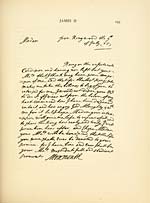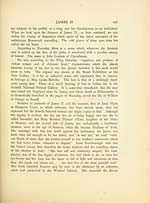Stuarts
(256) Page 196
Download files
Complete book:
Individual page:
Thumbnail gallery: Grid view | List view

196 THE STUARTS
has been made to whitewash George Jeffreys, and Mr. Irving has pointed
out, with regard to the " Bloody Assizes " (as the trial and ruthless punish-
ment of the adherents of Monmouth have ever since been called), that the
question should be not " how many did Jeffreys put to death, but the degree
in which the Chief Justice, by his fierce and brutal demeanour, aggravated
the horrors of an unpleasant situation." An unpleasant situation forsooth !
It was so indeed for Lady Lisle and the hundreds of others who suffered,
who were hung in West country towns, or sold as slaves in Barbadoes. He
prays us to remember that the gaols were crammed with prisoners from
Monmouth's army, and that clemency was not in those days " the accepted
spirit in which to greet the vanquished adherents of a great rising." Else-
where, however (and this is a passage which especially links the Judge with
our subject), he admits that James II. and Jeffreys were a most unfortunate
combination to be entrusted with the suppression of a rebellion. They
reacted fatally on one another. The cold implacability of the one was sup-
plemented by the "great and fiery passion" of the other: "the still resent-
ment of the King was augmented by the loud and mocking virulence of
the Judge. Those who escaped the fiery darts of Jeffreys were shattered
against the marble of James's heart."
Jeffreys was rather above the average height, with marked but by no
means disagreeable features, a fair complexion, piercing eyes, bushy eye-
brows and a commanding forehead. He was a man of considerable talents
and some social gifts, and is reported to have been a great judge of music ;
but neither his judicial brutality, nor his political profligacy admits of pallia-
tion. Devoid of principle, drunken and extravagant, a master of scurrilous
invective, he could be pleasant and agreeable enough when he liked. He
died when but forty-one, having been Chief Justice of the King's Bench at
thirty-five and Lord Chancellor at thirty-seven. There is a rather rudely
executed old print extant, showing his capture at Wapping, which reflects
the popular hatred that Macaulay has depicted in such terrible colours.
Returning to James II., a few words may be said anent his portrait
here shown. It is by one of the greatest artists-in-little who ever worked in
this country — Samuel Cooper. This superb miniature is at Windsor ; in the
space of a thumbnail we have the whole character of the man set forth.
We can read his nature in his face, and are prepared, as it were, for the
misfortunes which overtook him. Here is a man with many of the faults of
Charles II., and without the engaging qualities of his brother, which blinded
has been made to whitewash George Jeffreys, and Mr. Irving has pointed
out, with regard to the " Bloody Assizes " (as the trial and ruthless punish-
ment of the adherents of Monmouth have ever since been called), that the
question should be not " how many did Jeffreys put to death, but the degree
in which the Chief Justice, by his fierce and brutal demeanour, aggravated
the horrors of an unpleasant situation." An unpleasant situation forsooth !
It was so indeed for Lady Lisle and the hundreds of others who suffered,
who were hung in West country towns, or sold as slaves in Barbadoes. He
prays us to remember that the gaols were crammed with prisoners from
Monmouth's army, and that clemency was not in those days " the accepted
spirit in which to greet the vanquished adherents of a great rising." Else-
where, however (and this is a passage which especially links the Judge with
our subject), he admits that James II. and Jeffreys were a most unfortunate
combination to be entrusted with the suppression of a rebellion. They
reacted fatally on one another. The cold implacability of the one was sup-
plemented by the "great and fiery passion" of the other: "the still resent-
ment of the King was augmented by the loud and mocking virulence of
the Judge. Those who escaped the fiery darts of Jeffreys were shattered
against the marble of James's heart."
Jeffreys was rather above the average height, with marked but by no
means disagreeable features, a fair complexion, piercing eyes, bushy eye-
brows and a commanding forehead. He was a man of considerable talents
and some social gifts, and is reported to have been a great judge of music ;
but neither his judicial brutality, nor his political profligacy admits of pallia-
tion. Devoid of principle, drunken and extravagant, a master of scurrilous
invective, he could be pleasant and agreeable enough when he liked. He
died when but forty-one, having been Chief Justice of the King's Bench at
thirty-five and Lord Chancellor at thirty-seven. There is a rather rudely
executed old print extant, showing his capture at Wapping, which reflects
the popular hatred that Macaulay has depicted in such terrible colours.
Returning to James II., a few words may be said anent his portrait
here shown. It is by one of the greatest artists-in-little who ever worked in
this country — Samuel Cooper. This superb miniature is at Windsor ; in the
space of a thumbnail we have the whole character of the man set forth.
We can read his nature in his face, and are prepared, as it were, for the
misfortunes which overtook him. Here is a man with many of the faults of
Charles II., and without the engaging qualities of his brother, which blinded
Set display mode to:
![]() Universal Viewer |
Universal Viewer | ![]() Mirador |
Large image | Transcription
Mirador |
Large image | Transcription
Images and transcriptions on this page, including medium image downloads, may be used under the Creative Commons Attribution 4.0 International Licence unless otherwise stated. ![]()
| Histories of Scottish families > Stuarts > (256) Page 196 |
|---|
| Permanent URL | https://digital.nls.uk/95242123 |
|---|
| Description | A selection of almost 400 printed items relating to the history of Scottish families, mostly dating from the 19th and early 20th centuries. Includes memoirs, genealogies and clan histories, with a few produced by emigrant families. The earliest family history goes back to AD 916. |
|---|

